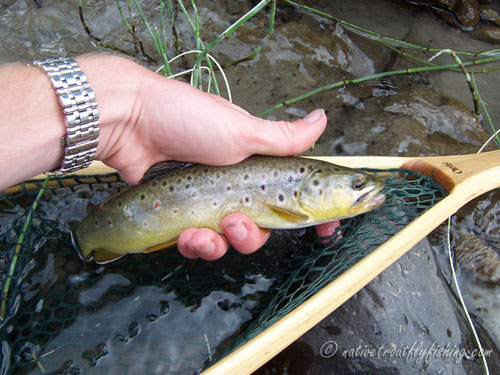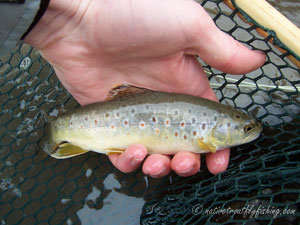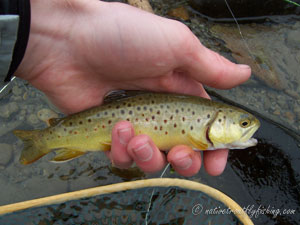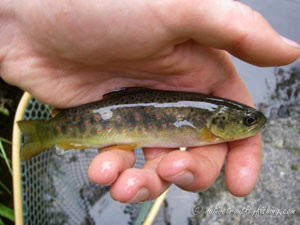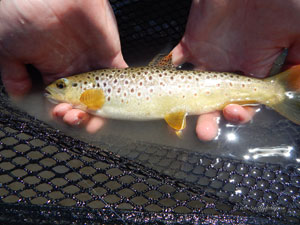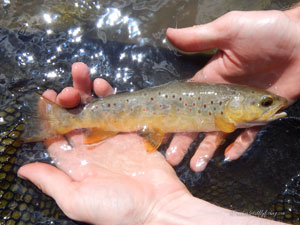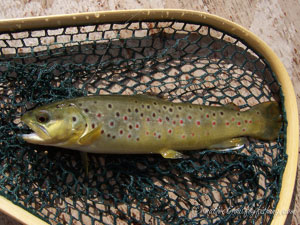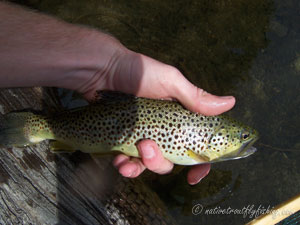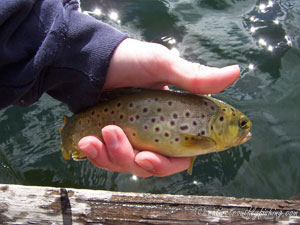Brown Trout
Salmo trutta
A Brown Trout from a Yellowstone National Park stream, these fish are not native to any North American waters.
Introduction
No matter where you catch brown trout in America, they are not native. These trout were originally brought over to America from Europe in the late 1800's and since that time they have become established in vast number of bodies of water across the continent. Brown trout are held in high esteem by many anglers, mainly due to the fact that they tend to be much more difficult to catch than North America's native trout. However despite their popularity these fish have also been a major factor in the decline of native species of trout. This is especially true in the especially in the southwest, where these fish are major predators and competitors of the native cutthroat, Apache and Gila trout.
Life History Information
Due to the fact that brown trout are not native to North America their life history will only be briefly covered here. Brown Trout exhibit stream resident, fluvial, adfluvial and when access to saltwater exists anadromous life history forms. Small stream Brown Trout tend to be under 12", however adfluvial and fluvial Brown Trout often attain sizes of between 14" and 30". Smaller Brown Trout tend to have a similar diet to other species of trout found in North America, relying heavily on aquatic and terrestrial insects and crustaceans. According to Elliot (1973) stream resident Brown and Rainbow Trout of similar sizes consumed the same amount and type of drifting insects, with most feeding occurring in the evening. Browns are known to feed extensively at night and have much better developed night vision than Rainbow, Cutthroat and Brook Trout. Once Brown Trout reach a large enough size, they often switch to a diet of primarily other fish allowing their growth rate to speed up. Not only does the growth of piscivorous Brown Trout tend to speed up, but these fish also tend to have a much longer lifespan too (Behnke 2002). By nature, Brown Trout are a weary fish and often tend to be much pickier than other trout species. Brown Trout are a fall spawning fish and typically reach sexual maturity at between two to three years of age, but may live to be over fifteen years old. The anadromous form of Brown Trout, is relatively rare in North America, although there are some established populations in Eastern Canada and these fish may reach weights of 25 to 30lbs. A semi-anadromous life history tends to be slightly more common in North America, with Brown Trout making short feeding forays into estuarine waters instead of extended oceanic migrations.
Description
The appearance of Brown Trout varies considerably from one individual to the next. This is partially due to several stocks being used when these fish were introduced, with the two most notable being the Loch Levan Brown Trout and Brown Trout from the Black Forest region of Germany. Brown Trout may be spotted with only black spots, or both black and red spots and these spots are typically surrounded by white halos. As mentioned there is much variation found in the appearance of Brown Trout across American and their spotting may be sparse of so dense that their spots are interconnected. As coloration goes, most of these trout exhibit a brown color on their backs and golden-brown color on their lower sides. Adfluvial and anadromous stocks may be rather silvery, although they will revert to more typical Brown Trout coloration as spawning comes on.
Stream Resident Form
Click on images to view a larger picture
Lacustrine Form
Contact
Feel free to contact me if you have any questions or comments
Native Trout Links
Truchas Mexicanas' - Native Trout of Mexico
Balkan Trout Restoration Group
Trout and Seasons of the Mountain Village - About Japanese Trout
Western Native Trout Challenge
California Heritage Trout Challenge
Fly Fishing Blogs
Dave B's Blog: Fly Fishing for Native Trout
The Search for Native Salmonids
Conservation Links
Western Native Trout Initiative
Fly Fishing Links
Fishing Art Links
Americanfishes.com - Joseph R. Tomelleri
